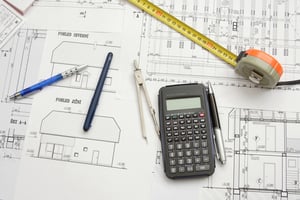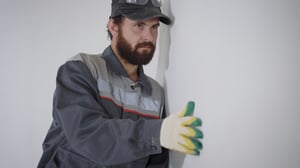A safe room is a structure specifically designed to provide maximum protection during severe weather, including hurricanes. It can be the difference between safety and disaster for you and your loved ones.
Looking to build a proper hurricane safe room, or maybe just analyze your existing one to see how it measures up? We’ll take a look at the steps which should go into the selection, modification, and preparation of a hurricane safe room.
Learn More About Hurricane Safety:
- A Florida Homeowner's Guide to Hurricane Safety
- Does Your Home Have Strong Hurricane Protection? Take Our Quiz!
- How Hurricane Glass Protects Your Home Compared to Regular Windows
Step 1) Choose a Location
 Location plays a major role in determining just how safe a hurricane safe room will be. Interior rooms are typically safer, but the geographic location of your home will play a strong role in selecting a space.
Location plays a major role in determining just how safe a hurricane safe room will be. Interior rooms are typically safer, but the geographic location of your home will play a strong role in selecting a space.
If you live in an area prone to flooding, a basement safe room (or any below ground level) is probably a bad idea. In this case, choosing a centrally located room in your home is the best bet, as it will be one of the last to take on water.
If you live on a hill, a structurally sound basement might be the safest possible location for a safe room. Consider your location as part of the planning process!
You should also consider accessibility in locating an ideal safe room location. An upstairs or basement safe room, independent of any other factors, may be difficult for older or physically-impaired members of your family to reach on their own. Think of each member of your family and their accessibility needs. The easiest rooms to access should automatically make the top of your list.
Step 2) Assess Room Structure
 Effective safe-at-home storm shelters should, above all else, be structurally sound. Ideally, this space will remain standing even if the rest of your home comes down around it. This is an argument against some basement safe rooms, as the weight of your home potentially crashing down through the floor can be a serious risk.
Effective safe-at-home storm shelters should, above all else, be structurally sound. Ideally, this space will remain standing even if the rest of your home comes down around it. This is an argument against some basement safe rooms, as the weight of your home potentially crashing down through the floor can be a serious risk.
You want, if possible, steel-reinforced concrete on all walls. Barring that, wood-reinforced concrete masonry is viable. What you don’t want, unless you have no other options, is simple wood-and-drywall construction. You could also consider various forms of concealed reinforcement for the interior wall of an existing room, including steel, special fibers, and concrete.
This will likely require professional work, but it’s certainly possible to use FEMA’s construction guidelines for safe rooms to bring structural elements up to safe levels.
Step 3) Install Storm Doors and Windows
 Any entry or exit point in your interior storm shelter is a point of failure if you don’t plan carefully. That means installing hurricane-ready storm doors and windows instead of standard options.
Any entry or exit point in your interior storm shelter is a point of failure if you don’t plan carefully. That means installing hurricane-ready storm doors and windows instead of standard options.
It may be tempting to forego windows of any kind in a hurricane safe room, but there are arguments in favor of including them:
- They can provide a path of egress
- They allow for visibility to assess weather changes
- They are often legally mandated if your hurricane room is going to also serve as a bedroom space.
Step 4) Evaluate Secondary Hazards Potential
 You shouldn’t settle for safe rooms being merely structurally safe; after all, severe storms can have unexpected effects on your home, and you’re going to potentially be stuck in there for a while.
You shouldn’t settle for safe rooms being merely structurally safe; after all, severe storms can have unexpected effects on your home, and you’re going to potentially be stuck in there for a while.
For instance, make sure there’s zero risk that you’ll end up with any electrical injuries because of flooding affecting outlets. In addition, any items in the room, such as bookcases, wall decorations, or ceiling fixtures should be secured to the highest safety standards (or removed entirely) to ensure nothing could fall over and injure or trap you or a loved one.
Outfitting Your Hurricane Safe Room
 Of course, a safe room shouldn’t be a featureless, empty box to sit in indefinitely. Make sure it’s outfitted to carry you and your family through the storm, however long it may be. This means packing a hurricane safety kit, some form of entertainment to keep you occupied, bedding, etc. You may not be comfortably stuffed in a safety room, but you’ll certainly be more comfortable if you plan thoroughly beforehand.
Of course, a safe room shouldn’t be a featureless, empty box to sit in indefinitely. Make sure it’s outfitted to carry you and your family through the storm, however long it may be. This means packing a hurricane safety kit, some form of entertainment to keep you occupied, bedding, etc. You may not be comfortably stuffed in a safety room, but you’ll certainly be more comfortable if you plan thoroughly beforehand.
Ultimately, your safe room will be as secure, safe, and comfortable as the investment of time and resources you put into it. Plan carefully, invest wisely, and you’ll ride out every storm accordingly.
OTHER RESOURCES TO CONSIDER
In addition to preparing a basic emergency supply kit, take time to formulate a family hurricane plan to keep everyone organized when severe weather hits.
For even more guidance, read the Essential Hurricane Safety Handbook for Florida Residents.

When planning to install impact windows or doors for your property, start with Alco Windows and Doors. Contact them today for a consultation or visit them online at www.alcoimpact.com.




 License # CGC1526312
License # CGC1526312
Leave a Reply